Full-Scale Experimental Study of Shear and Flexural Behavior of 16-m Retired Reinforced Concrete T-Beams
Abstract
1. Introduction
2. Experimental Program
2.1. Engineering Background
2.2. Details of the Tested Beams
3. Full-Scale Test
3.1. Loading Test Setup
3.2. Loading Program
4. Results and Discussion
4.1. Test Results
4.1.1. Flexural Test
4.1.2. Shear Test
4.2. Deflection Responses
4.3. Concrete Strain
4.3.1. Load–Strain Curves on the Top Flange and Web Bottom
4.3.2. Strain Distribution at the Mid-Span Section of Flexural Test Beams
4.3.3. Principal Tensile Strain at Shear Span of the Shear Test Beam
4.4. Flexural and Shear Capacity of Retired Beams Calculated by Chinese Code
5. Conclusions
- (1)
- In the flexural test, when the loading exceeded 250 kN, existing cracks on one side of the test beams began to reopen and extend upwards. Beam F-1 had a flexural strengthening steel plate fracture at the bottom of the mid-span when loaded to 1564.4 kN, and the loading began to decrease afterwards. Beam F-2 experienced a sudden increase in the width of a diagonal crack at one side; hence, the load-carrying capacity decreased. At the end of the test, a major diagonal crack that developed from the shear-bending diagonal crack appeared in beam F-2.
- (2)
- In the shear test, new cracks appeared in all the test beams when the applied load exceeded 300 kN. The loading of beam S-1 was stopped due to the apparent separation between the shear-strengthening steel plate and the beam. The testing of beams S-2 and S-3 ended with an abrupt explosion of sound. There were fewer cracks in beams S-2 and S-3 than in beam S-1. None of the three shear test beams developed a major crack by the end of the test.
- (3)
- The ultimate load of each test beam exceeded 1400 kN, and the deflection at the loading point was more than 40 mm; this revealed that the retired full-scale beams exhibited high load-carrying capacity and ductile damage characteristics after long-term service.
- (4)
- Comparing the test values with the calculation results of JTG-3362-2018, the retired beams have adequate safety margins. The value of Me/Mc of the flexural test beam is about 1.4, and the value of Ve/Vc of the shear test beam is about 1.5.
Author Contributions
Funding
Data Availability Statement
Acknowledgments
Conflicts of Interest
References
- Wang, B.; Wang, K.; Liu, X.; Xu, Y. Residual Flexural Capacity of Composite Beams with Corroded Studs after Fatigue. J. Bridge Eng. 2023, 28, 04023026. [Google Scholar] [CrossRef]
- Fang, S.; Li, L.; Luo, Z.; Fang, Z.; Huang, D.; Liu, F.; Wang, H.; Xiong, Z. Novel FRP interlocking multi-spiral reinforced-seawater sea-sand concrete square columns with longitudinal hybrid FRP-steel bars: Monotonic and cyclic axial compressive behaviours. Compos. Struct. 2023, 305, 116487. [Google Scholar] [CrossRef]
- Gopu, G.; Sofi, A. The influence of fiber RC beams under flexure on the chloride-induced corrosion. Case Stud. Constr. Mater. 2022, 17, e01566. [Google Scholar] [CrossRef]
- Budak, E.; Sucuoğlu, H.; Celik, O. Response parameters that control the service, safety and collapse performances of a 253 m tall concrete core wall building in Istanbul. Bull. Earthq. Eng. 2023, 21, 375–395. [Google Scholar] [CrossRef]
- Liu, C.; Wang, P.; Lu, X.; Miao, J.; Wang, X. Residual flexural behaviour comparison between composite and monolithic beams after fire exposure. J. Build. Eng. 2023, 64, 105584. [Google Scholar] [CrossRef]
- Liu, L.; Yang, X.; Yan, B.; Miao, S. Dynamic responses of RC girder bridge under heavy truck and seismic loads combined. Sustainability 2022, 14, 9263. [Google Scholar] [CrossRef]
- Gong, F.; Wang, Z.; Xia, J.; Maekawa, K. Coupled thermo-hydro-mechanical analysis of reinforced concrete beams under the effect of frost damage and sustained load. Struct. Concr. 2021, 22, 3430–3445. [Google Scholar] [CrossRef]
- Jiang, H.; Huang, C.; Mei, G.; Gao, X.; Tian, Y.; Sun, X. Experimental and numerical investigations on direct shear performance of UHPC dry joints. Eng. Struct. 2023, 283, 115872. [Google Scholar] [CrossRef]
- Fang, S.; Zhang, S.; Cao, Z.; Zhao, G.; Fang, Z.; Ma, Y.; Jiang, H. Effects of stud aspect ratio and cover thickness on push-out performance of thin full-depth precast UHPC slabs with grouped short studs: Experimental evaluation and design considerations. J. Build. Eng. 2023, 67, 105910. [Google Scholar] [CrossRef]
- Ji, X.; Zhu, L.; Su, R.; Wang, G. Lateral overturning process and failure mechanism of curved steel-concrete composite box-girder bridges under specific overloading vehicles. Structures 2022, 35, 638–649. [Google Scholar] [CrossRef]
- Fiandaca, D.; Matteo, A.; Patella, B.; Moukri, N.; Inguanta, R.; Llort, D.; Mulone, A.; Mulone, A.; Alsamahi, A.; Pirrotta, A. An integrated approach for structural health monitoring and damage detection of bridges: An experimental assessment. Appl. Sci. 2022, 12, 13018. [Google Scholar] [CrossRef]
- Ogunniyi, E.; Vareen, A.; Downey, A.; Laflamme, S.; Li, J.; Bennett, C.; Collins, w.; Jo, H.; Henderson, A.; Ziehl, P. Investigation of electrically isolated capacitive sensing skins on concrete to reduce structure/sensor capacitive coupling. Meas. Sci. Technol. 2023, 34, 055113. [Google Scholar] [CrossRef]
- Shevtsov, D.; Cao, N.; Nguyen, V.; Nong, Q.; Le, H.; Nguyen, D.; Zartsyn, I.; Kozaderov, O. Progress in Sensors for Monitoring Reinforcement Corrosion in Reinforced Concrete Structures—A Review. Sensors 2022, 22, 3421. [Google Scholar] [CrossRef] [PubMed]
- Aktan, A.E.; Zwick, M.; Miller, R.; Shahrooz, B. Nondestructive and Destructive Testing of Decommissioned Reinforced Concrete Slab Highway Bridge and Associated Analytica Studies; Transportation Research Board: Washington, DC, USA, 1992. [Google Scholar]
- Wardach, M.; Krentowski, J.; Knyziak, P. Degradation Analyses of Systemic Large-Panel Buildings Using Comparative Testing during Demolition. Materials 2022, 15, 3770. [Google Scholar] [CrossRef] [PubMed]
- Miller, R.; Aktan, A.; Shahrooz, B. Destructive testing of decommissioned concrete slab bridge. J. Struct. Eng. 1994, 120, 2176–2198. [Google Scholar] [CrossRef]
- Song, H.; You, D.; Byun, K.; Maekawa, K. Finite element failure analysis of reinforced concrete T-girder bridges. Eng. Struct. 2002, 24, 151–162. [Google Scholar] [CrossRef]
- Qu, G.; Zhou, G.; Huang, P.; Han, W.; Gong, W.; Yuan, Y. In-house destructive test of dismantled component of existing hollow slab bridge. J. Chang. Univ. (Nat. Sci. Ed.) 2019, 39, 57–66. (In Chinese) [Google Scholar]
- Li, Y.; Zhang, J.; Yu, B. Study on Ultimate Bearing Capacity of an Existing RC T-girder Bridge. J. Highw. Transp. Res. Dev. 2017, 34, 66–71. (In Chinese) [Google Scholar]
- Fu, X.; Wu, R. Experimental Research on Carrying Capacity of Prestressed Concrete Small Box Girder Based on Failure Test. Technol. Highw. Transp. 2020, 36, 54–66. (In Chinese) [Google Scholar]
- Wang, J.; Tang, S.; Zheng, H.; Zhou, C.; Zhu, M. Flexural behavior of a 30-meter full-scale simply supported prestressed concrete box girder. Appl. Sci. 2020, 10, 3076. [Google Scholar] [CrossRef]
- Huffman, J.M. Destructive Testing of a Full-Scale 43 Year Old Adjacent Prestressed Concrete Box Beam Bridge: Middle and West Spans; Ohio University: Athens, OH, USA, 2012. [Google Scholar]
- Wang, C.; Wang, S.; Wang, Q.; Shen, J.; Duan, L. Experimental Study on Bearing Capacity of Dangerous and/or Old Pre-stressed Concrete Box Girders. Eng. Mech. 2019, 36, 171–181. (In Chinese) [Google Scholar]
- Eder, R.; Miller, R.; Baseheart, T.; Swanson, J. Testing of two 50-year-old precast post-tensioned concrete bridge girders. PCI J. 2005, 50, 90–95. [Google Scholar] [CrossRef]
- Pape, T.; Melchers, R. The effects of corrosion on 45-year-old pre-stressed concrete bridge beams. Struct. Infrastruct. Eng. 2011, 7, 101–108. [Google Scholar] [CrossRef]
- Dasar, A.; Irmawaty, R.; Hamada, H.; Sagawa, Y.; Yamamoto, D. Prestress Loss and Bending Capacity of Pre-cracked 40 Year-Old PC Beams Exposed to Marine Environment. In Proceedings of the 3rd International Conference on Civil and Environmental Engineering for Sustainability (IConCEES 2015), Melaka, Malaysia, 1–2 December 2015. [Google Scholar]
- Recupero, A.; Spinella, N. Experimental tests on corroded prestressed concrete beams subjected to transverse load. Struct. Concr. 2019, 20, 2220–2229. [Google Scholar] [CrossRef]
- Rogers, R.; Wotherspoon, L.; Scott, A.N.; Ingham, J. Residual strength assessment and destructive testing of decommissioned concrete bridge beams with corroded pretensioned reinforcement. PCI J. 2012, 57, 100–118. [Google Scholar] [CrossRef]
- Lundqvist, P.; Riihimäki, J. Testing of five 30-year-old prestressed concrete beams. PCI J. 2010, 55, 50–58. [Google Scholar] [CrossRef]
- Du, M.; Zong, Z.; Liao, Y.; Li, M. Shear bearing capacity of existing prestressed concrete hollow slab girder. J. Southeast Univ. (Nat. Sci. Ed.) 2021, 51, 384–390. (In Chinese) [Google Scholar]
- Lantsoght, E.O.L.; Zarate, G.; Zhang, F.; Park, M.K.; Yang, Y.; Sliedrecht, H. Shear experiments of prestressed concrete bridge girders. ACI Struct. J. 2021, 118, 117–130. [Google Scholar]
- Lantsoght, E.O.; Van der Veen, C.; Koekkoek, R.; Sliedrecht, H. Punching capacity of prestressed concrete bridge decks under fatigue. ACI Struct. J. 2019, 116, 209–218. [Google Scholar] [CrossRef]
- Lantsoght, E.O.; Van der Veen, C.; Koekkoek, R.; Sliedrecht, H. Fatigue testing of transversely prestressed concrete decks. ACI Struct. J. 2019, 116, 143–153. [Google Scholar] [CrossRef]
- Schmidt, J.W.; Hansen, S.G.; Barbosa, R.A.; Henriksen, A. Novel shear capacity testing of ASR damaged full scale concrete bridge. Eng. Struct. 2014, 79, 365–374. [Google Scholar] [CrossRef]
- Taffe, A.; Hillemeier, B.; Walther, A. Condition Assessment of a 45-year-old prestressed concrete bridge using NDT and verification of the results. Struct. Mater. Technol. 2010. [Google Scholar] [CrossRef]
- Savino, P.; Tondolo, F.; Sabia, D.; Quattrone, A.; Biondini, F.; Rosati, G.; Anghileri, M.; Chiaia, B. Large-Scale Experimental Static Testing on 50-Year-Old Prestressed Concrete Bridge Girders. Appl. Sci. 2023, 13, 834. [Google Scholar] [CrossRef]
- Anghileri, M.; Biondini, F.; Rosati, G.; Savino, P.; Tondolo, F.; Sabia, D.; Manto, S.; Nivriera, M.; Trincianti, C.; Ventura, D.; et al. Deconstruction of the Corso Grosseto viaduct and setup of a testing site for full scale load tests. In Bridge Maintenance, Safety, Management, Life-Cycle Sustainability and Innovations; CRC Press: Boca Raton, FL, USA, 2021; pp. 3365–3370. [Google Scholar]
- Shu, J.; Bagge, N.; Nilimaa, J. Field destructive testing of a reinforced concrete bridge deck slab. J. Bridge Eng. 2020, 25, 04020067. [Google Scholar] [CrossRef]
- Jeon, C.; Sim, C.; Shim, C. The effect of wire rupture on flexural behavior of 45-year-old post-tensioned concrete bridge girders. Eng. Struct. 2021, 245, 112842. [Google Scholar] [CrossRef]
- Liu, J.; Jia, Y. Destructive testing of twenty-year-old prestressed concrete bridge beams in freezing-thawing region. Civ. Eng. J. 2019, 28, 344–356. [Google Scholar] [CrossRef]
- Kramer, W.; Martin, W.; Viljoen, H. Demolition of Old Oak Bridge B4113: Condition of a 54-year old prestressed concrete bridge. In Proceedings of the International Conference on Concrete Repair, Rehabilitation and Retrofitting (ICCRRR 2018), Cape Town, South Africa, 19–21 November 2018. [Google Scholar]
- Nilimaa, J.; Nilforoush, R. A Direct Tensile Strength Testing Method for Concrete from Existing Structures. CivilEng 2023, 4, 333–344. [Google Scholar] [CrossRef]
- Khalilpour, S.; BaniAsad, E.; Dehestani, M. A review on concrete fracture energy and effective parameters. Cem. Concr. Res. 2019, 120, 294–321. [Google Scholar] [CrossRef]
- Liu, L.; Yu, S.; Ma, X. Flexural capacity of RC beams reinforced with ECC layer and steel plate. J. Build. Eng. 2023, 65, 105781. [Google Scholar] [CrossRef]
- Abdel-Jaber, M.T. Influence of Externally Bonded CFRP on the Shear Behavior of Strengthened and Rehabilitated Reinforced Concrete T-Beams Containing Shear Stirrups. Fibers 2021, 9, 87. [Google Scholar] [CrossRef]
- Abdel-Jaber, M.E.; Abdel-Jaber, M.T.; Katkhuda, H.; Shatarat, N.; Sulaiman, A.; El-Nimri, R. Influence of stirrup spacing on the strengthening and rehabilitating of RC T-beams using near-surface mounted carbon-fiber-reinforced polymer strips. Fibers 2021, 10, 103. [Google Scholar] [CrossRef]
- Fang, H.; Gu, M.; Zhang, S.; Jiang, H.; Fang, Z.; Hu, J. Effects of Steel Fiber and Specimen Geometric Dimensions on the Mechanical Properties of Ultra-High-Performance Concrete. Materials 2022, 15, 3027. [Google Scholar] [CrossRef]
- Said, A.; Elsayed, M.; Abd El-Azim, A.; Althoey, F.; Tayeh, B.A. Using ultra-high performance fiber reinforced concrete in improvement shear strength of reinforced concrete beams. Case Stud. Constr. Mater. 2022, 16, e01009. [Google Scholar] [CrossRef]
- JTG/T H21-2011; Standards for Technical Condition Evaluation of Highway Bridges. Ministry of Transport of the People’s Republic of China: Beijing, China, 2011. (In Chinese)
- Feng, J.; Li, P.; Wu, J.; Jiang, H.; Tian, Y.; Sun, X. Shear behavior of externally prestressed UHPC beams without stirrups. Case Stud. Constr. Mater. 2023, 18, e01766. [Google Scholar] [CrossRef]
- Wu, Y. Analytical Approaches for Reinforced Concrete; Woodhead Publishing: Cambridge, UK, 2022. [Google Scholar]
- Fang, Z.; Fang, H.; Li, P.; Jiang, H.; Chen, G. Interfacial shear and flexural performances of steel–precast UHPC composite beams: Full-depth slabs with studs vs. demountable slabs with bolts. Eng. Struct. 2022, 260, 114230. [Google Scholar] [CrossRef]
- JTG 3362—2018; Specifications for Design of Highway Reinforced Concrete and Prestressed Concrete Bridges and Culverts. China Communications Press: Beijing, China, 2018. (In Chinese)
- GB 50010-2010; Code for Design of Concrete Structures. Ministry of Transport of the People’s Republic of China: Beijing, China, 2010. (In Chinese)
- Melhem, M.M.; Caprani, C.C.; Stewart, M.G. Reliability updating of partial factors for empirical codes: Application to Super-T PSC girders designs at the ultimate limit state in bending. Structures 2022, 35, 233–242. [Google Scholar] [CrossRef]
- Fang, Z.; Hu, L.; Jiang, H.; Fang, S.; Zhao, G.; Ma, Y. Shear performance of high-strength friction-grip bolted shear connector in prefabricated steel–UHPC composite beams: Finite element modelling and parametric study. Case Stud. Constr. Mater. 2023, 18, e01860. [Google Scholar] [CrossRef]



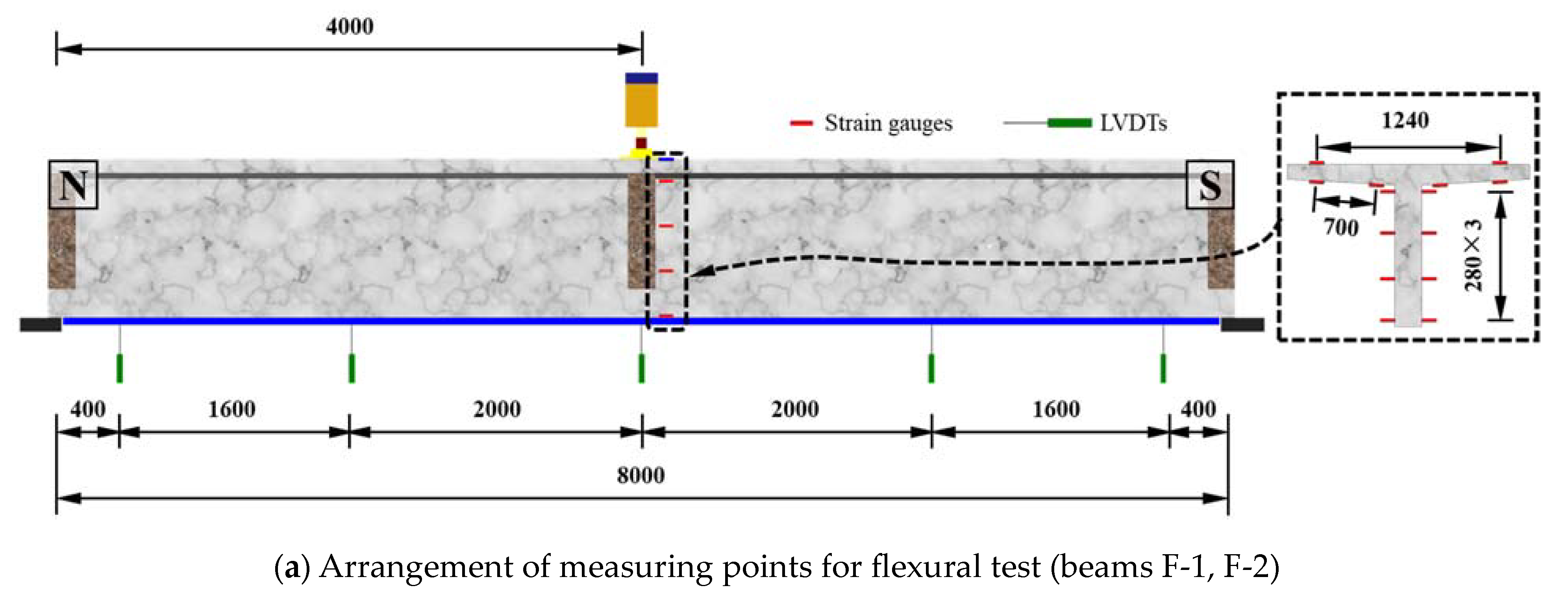

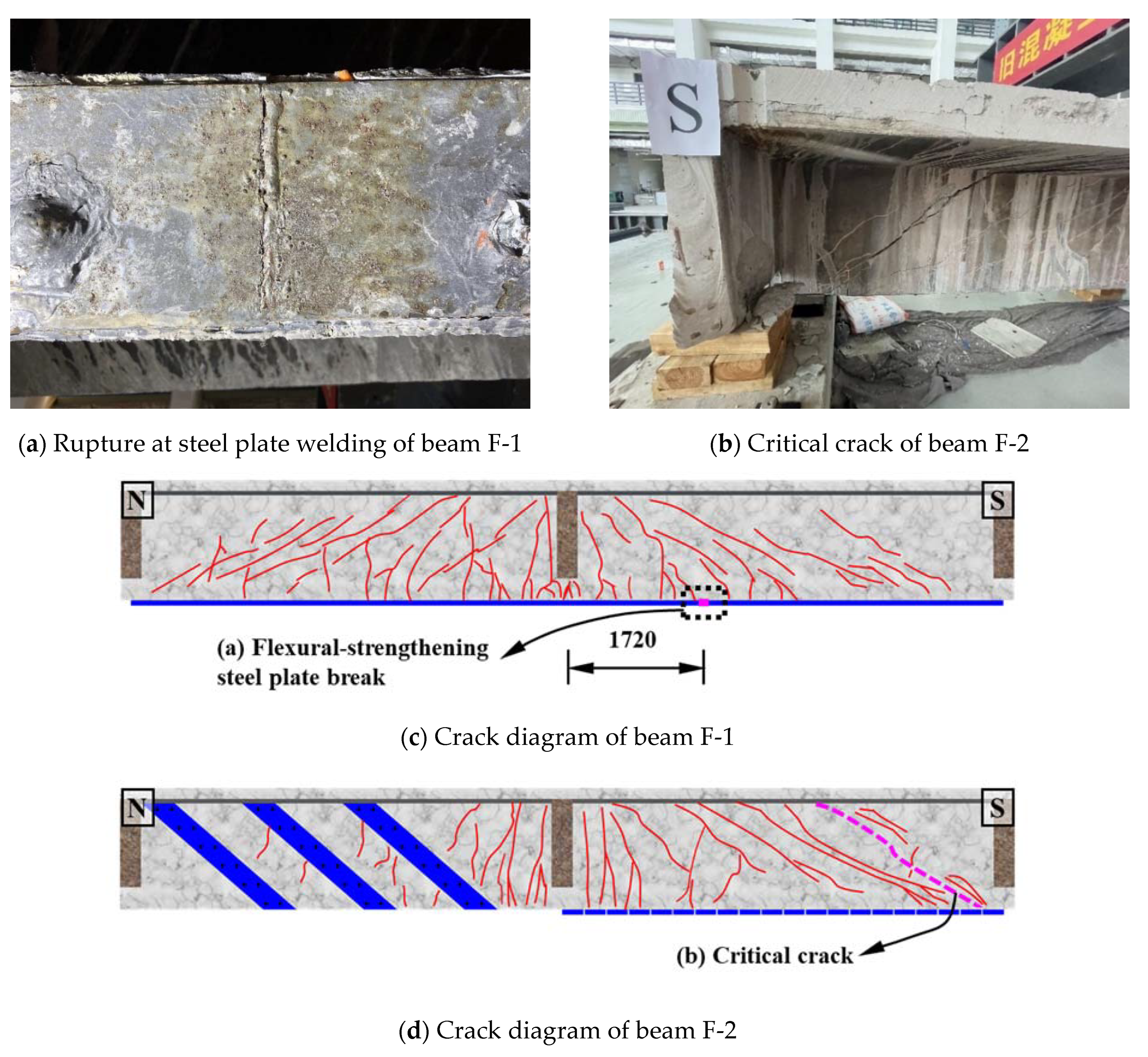
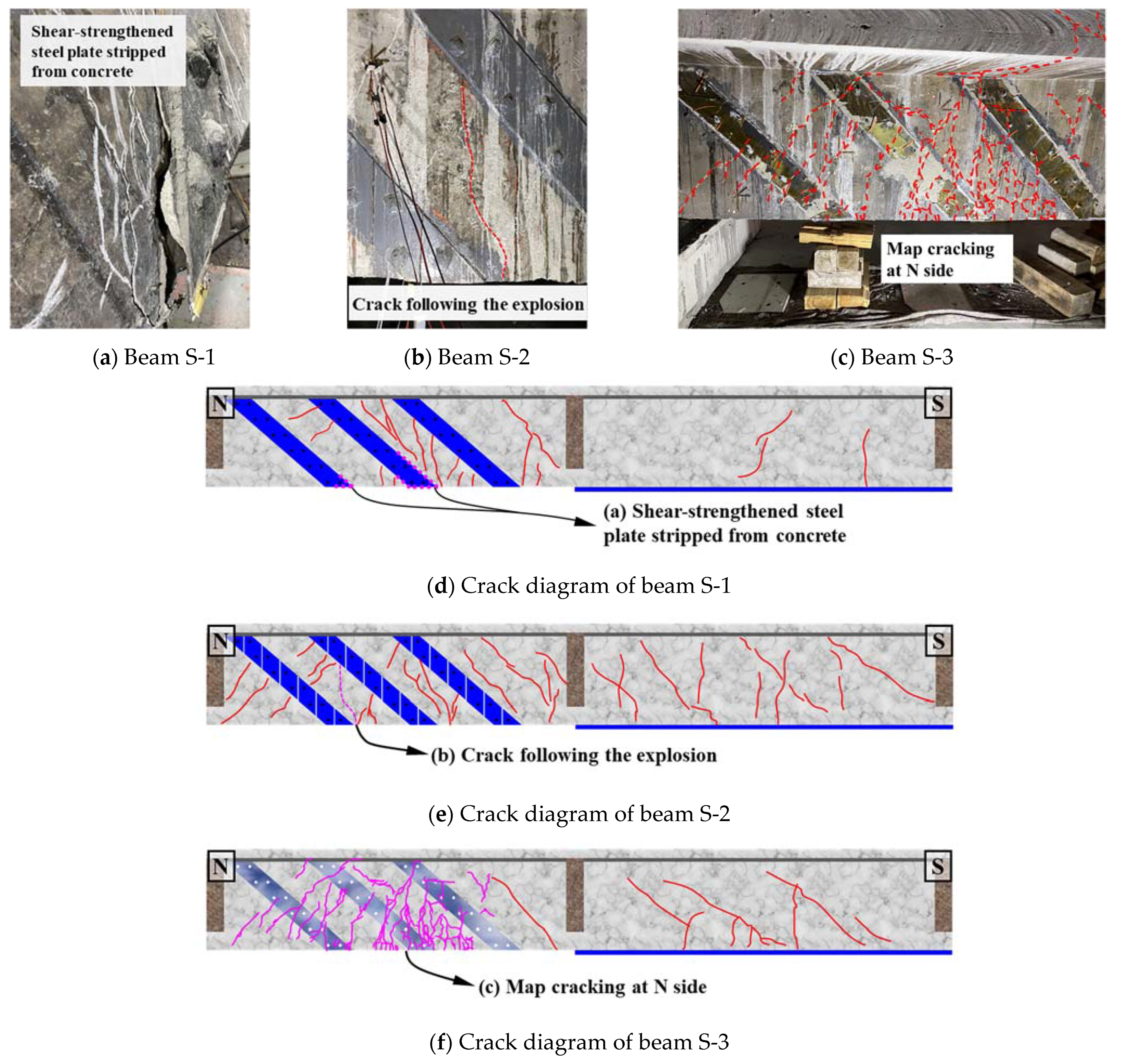
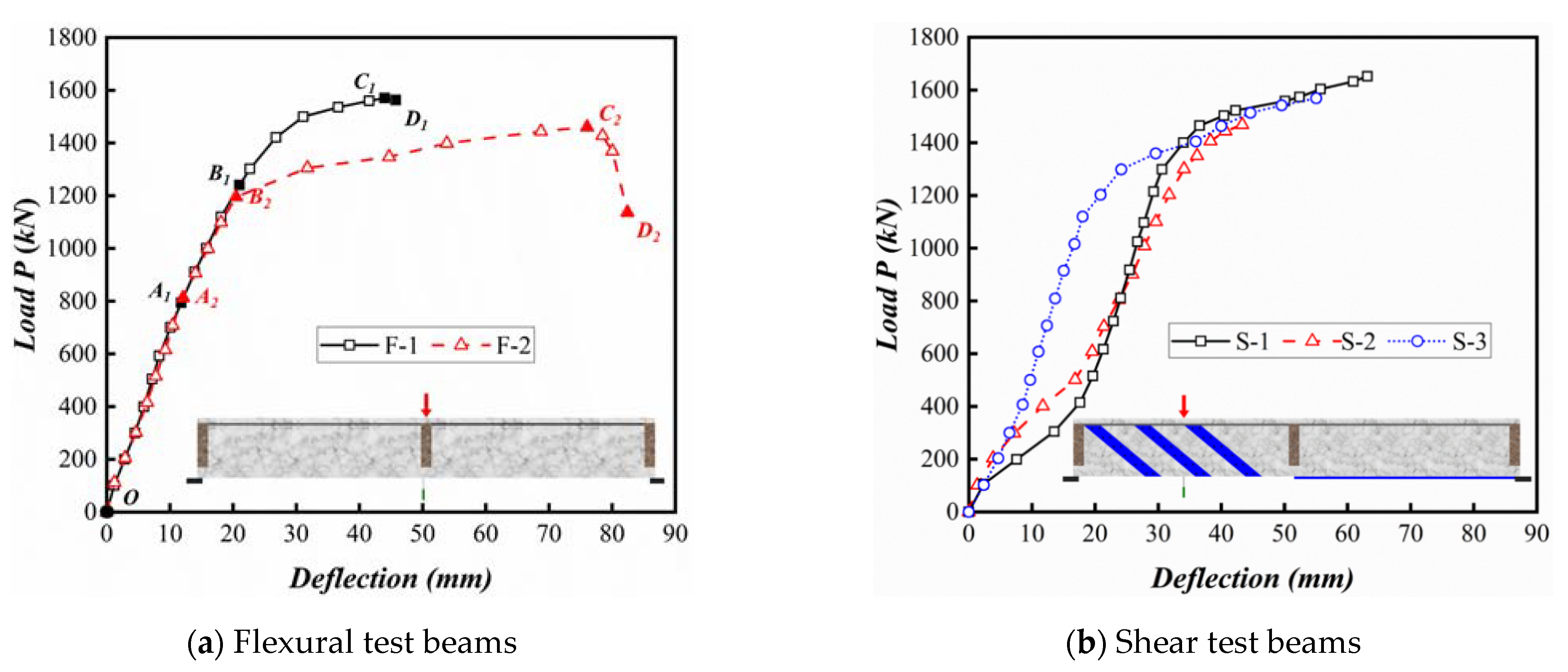

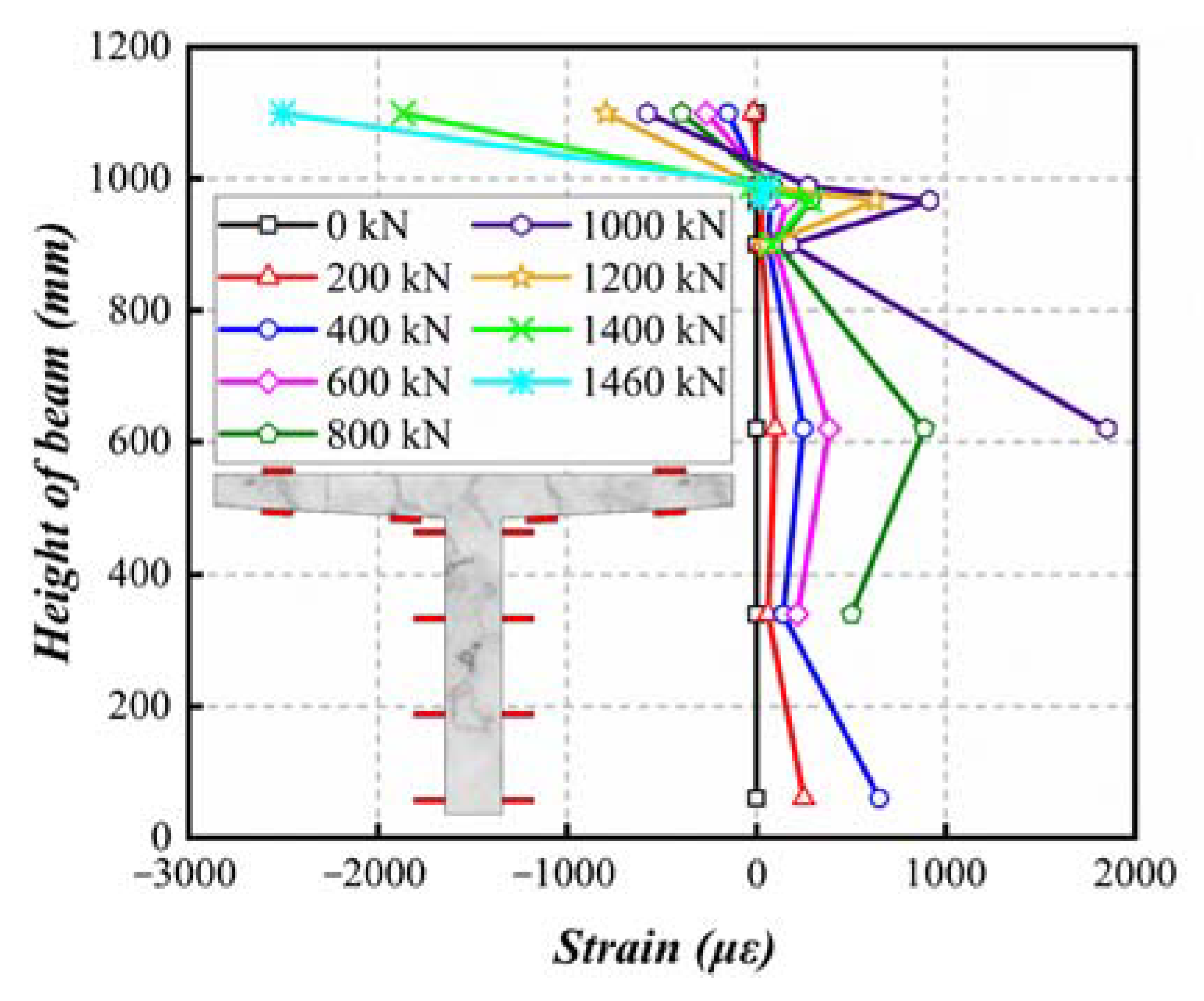

| Load | Vehicle Load | Crowd Load | Flat Trailer Load |
|---|---|---|---|
| Load level | Truck-20 | 3.5 kN/m2 | Trailer-100 |
| Test Beam | Test Type | Shear Span-to-Height Ratio | Rehabilitation Measure | Rehabilitating Steel Plates |
|---|---|---|---|---|
| F-1 | Flexural test | 3.33 | Bending rehabilitation | Steel plates reserved |
| F-2 | Flexural test | 3.33 | Bending rehabilitation on one side and shear rehabilitation on the other | Bending reinforcement steel plates cut every 300 mm along the bridge axis |
| S-1 | Shear test | 1.67 | Bending reinforcement on one side and shear reinforcement on the other | Steel plates reserved |
| S-2 | Shear test | 1.67 | Bending reinforcement on one side and shear reinforcement on the other | Steel plates of shear rehabilitations were broken in the middle of two bolts |
| S-3 | Shear test | 1.67 | Bending reinforcement on one side and shear reinforcement on the other | Steel plates were totally removed |
| Test Beam | fs (MPa) | h’f (mm) | b’f (mm) | h0 (mm) |
|---|---|---|---|---|
| F-1 | 340 | 110 | 1600 | 990 |
| F-2 | 1000 | |||
| S-x | 1021 |
| Test Beam | α1 | α2 | α3 | fcu,k (MPa) | fsv (MPa) | θs | b (mm) |
|---|---|---|---|---|---|---|---|
| F-x, S-x | 1.0 | 1.0 | 1.1 | 30 | 235 | 45° | 180 |
| Specimen | Maximum Load Pe (kN) | Shear Force in Supporting Ve (kN) | Shear Bearing Capacity (kN) | The Maximum Moment at Loading Point Me (kN·m) | Bending Bearing Capacity at Loading Point Mc (kN·m) | Me/Mc | Deflection γ (mm) | |
|---|---|---|---|---|---|---|---|---|
| F-1 | 1564.38 | 817.61 | 692.19 | 1.18 | 3199.59 | 2335.03 | 1.37 | 42.56 |
| F-2 | 1455.86 | 763.35 | 699.24 | 1.09 | 2982.57 | 2051.01 | 1.45 | 73.80 |
| S-1 | 1654.79 | 1274.26 | 776.13 | 1.64 | 2530.81 | 1297.84 | 1.95 | 63.41 |
| S-2 | 1467.92 | 1136.36 | 776.13 | 1.46 | 2255.01 | 1297.84 | 1.73 | 43.32 |
| S-3 | 1553.83 | 1200.79 | 776.13 | 1.55 | 2383.87 | 1297.84 | 1.83 | 55.05 |
Disclaimer/Publisher’s Note: The statements, opinions and data contained in all publications are solely those of the individual author(s) and contributor(s) and not of MDPI and/or the editor(s). MDPI and/or the editor(s) disclaim responsibility for any injury to people or property resulting from any ideas, methods, instructions or products referred to in the content. |
© 2023 by the authors. Licensee MDPI, Basel, Switzerland. This article is an open access article distributed under the terms and conditions of the Creative Commons Attribution (CC BY) license (https://creativecommons.org/licenses/by/4.0/).
Share and Cite
Jiang, H.; Mo, F.; Chen, Z.; Wu, J.; Fang, H.; Fang, Z.; Zhang, S.; Xu, Z. Full-Scale Experimental Study of Shear and Flexural Behavior of 16-m Retired Reinforced Concrete T-Beams. Buildings 2023, 13, 2075. https://doi.org/10.3390/buildings13082075
Jiang H, Mo F, Chen Z, Wu J, Fang H, Fang Z, Zhang S, Xu Z. Full-Scale Experimental Study of Shear and Flexural Behavior of 16-m Retired Reinforced Concrete T-Beams. Buildings. 2023; 13(8):2075. https://doi.org/10.3390/buildings13082075
Chicago/Turabian StyleJiang, Haibo, Fan Mo, Zhiqin Chen, Jiajie Wu, Haozhen Fang, Zhuangcheng Fang, Shufeng Zhang, and Zhenming Xu. 2023. "Full-Scale Experimental Study of Shear and Flexural Behavior of 16-m Retired Reinforced Concrete T-Beams" Buildings 13, no. 8: 2075. https://doi.org/10.3390/buildings13082075
APA StyleJiang, H., Mo, F., Chen, Z., Wu, J., Fang, H., Fang, Z., Zhang, S., & Xu, Z. (2023). Full-Scale Experimental Study of Shear and Flexural Behavior of 16-m Retired Reinforced Concrete T-Beams. Buildings, 13(8), 2075. https://doi.org/10.3390/buildings13082075








